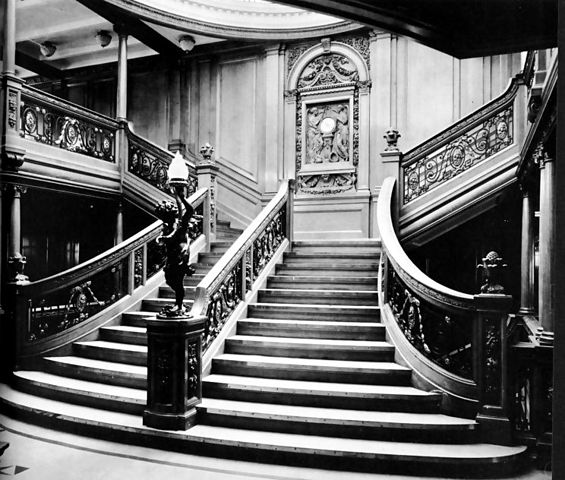
Photo:Public Domain (Wikipedia)
Titanic is en route to New York and people settle into their familiar patterns. Mealtimes are very popular to meet with your fellow travelers and all classes have a place to gather and eat. The ticket price covers all three meals though first class has its own a la carte restaurant where you can buy dishes sold separately. Food portions were plentiful, unlike earlier passenger liners, so you got a lot of food for the ticket. In many ways, Titanic and other ships that followed this pattern became adept in creating expert meals at any time of the day with a dedicated crew of food professionals with access to quality foods stored aboard the ship.
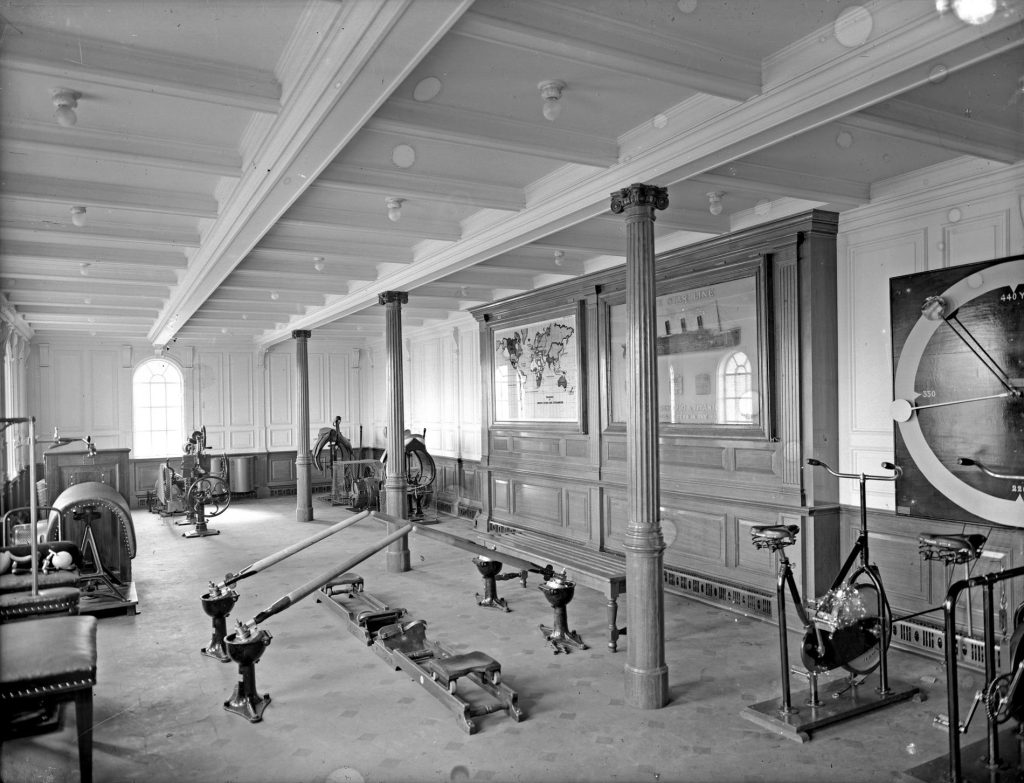
Photo: Robert Welch (1859–1936)
Public Domain via Wikimedia Commons
Working off all that food was not difficult either. You could take laps walking around the deck or use one of the many exercising equipment aboard. The gymnasium was quite impressive with punching bags, stationary bikes (called cycle racing machines), electric horse and camel, and a squash court (men and women played at different times). The mechanical rowing machine was apparently very popular. Of course, you could work up a sweat in the Turkish bath or treat yourself to a nice massage. There was an electric bath which today would be like a tanning bed. It was more of a curiosity than anything else. One had to exhibit a certain amount of bravery to get into something that looked like an iron lung.
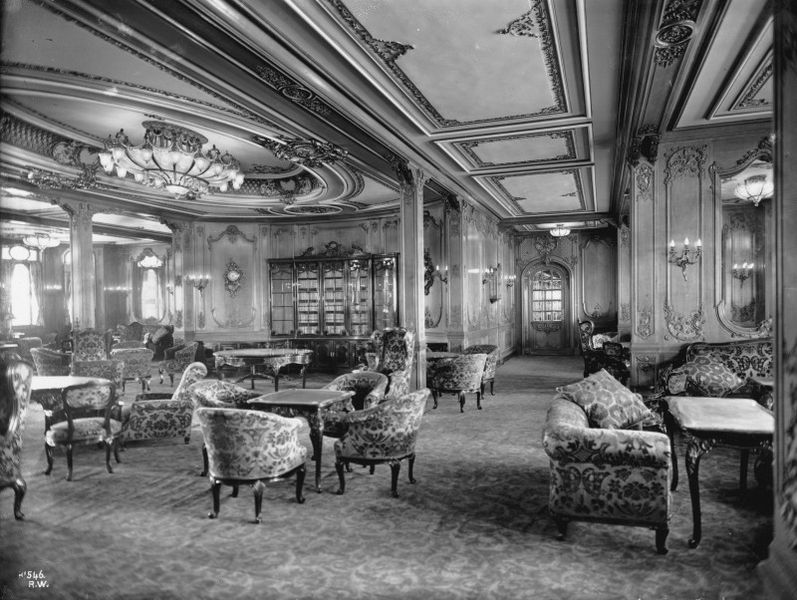
Photo: Robert John Welch (1859-1936), official photographer for Harland & Wolff
Public Domain/Wikimedia Commons
You might decide to relax in the library or send a telegram off to family using the Marconi wireless. April 13 was actually a nice day to be outside on the Titanic. Spring-like temperatures were in the upper 50’s, so one could enjoy walking the deck. Or you could be indoors in one of the smoke rooms playing cards. And there were professional gamblers aboard who made a living plying the ocean liners. They were known to White Star and other liners of the day, but the liners simply warned passengers that they were not responsible for such private games.
These gamblers were keen on trying to get as much money from those who could afford to lose. And they readily took advantage of the naïve and inexperienced. They did face steely competition though from men who, like the professional gambler, spent time in their gentleman’s clubs (not to be confused with its modern day nearly porn image with strippers) playing cards with other members. They usually were just as skilled as the professional gambler and knew what to watch out for.
Dinners were when everyone in first and second class had to appear in the right way. Men and women wore formal evening clothes. It was important to be seen properly attired for the meal especially the higher in status you were. To be seen in anything but such attire was unthinkable. A gentleman or lady who showed up in casual clothes for first- or second-class meals would not only get impolite stares but a discreet word that they must dress up to be seated. Breakfast was the only time you could be casual but even then, you did not show up looking sloppy or in gym clothes..
The main dining saloon was open to First- and Second-class passengers (Third Class ate in a separate area) and was open set hours for each meal. However, First Class passengers had exclusive access to the Al la Carte Restaurant, which served food from 8 am – 11 pm. Passengers who selected to eat only at this restaurant at the time of booking received a rebate of 3-5£ since they were paying for their own meals at this restaurant.
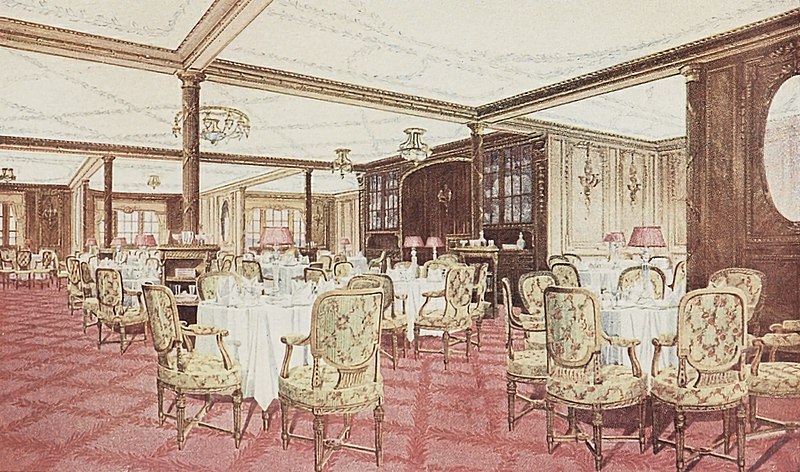
Public domain via Wikimedia Commons
The restaurant was not run by White Star, but a concession run by Luigi Gatti and staffed by its own workers. Modeled on the famous Ritz restaurant, it served French haute cuisine. This was certainly one of the most luxurious rooms on the ship decorated in the Louis XVI style, carved wooden paneling, fluted columns carved with gilded ribbons, and plaster ceilings decorated with flower and ribbon motifs. Mirrors were used to imitate windows and installed in the paneling. A large buffet with a peach-colored marble top graced the forward wall with a raised bandstand for the orchestra. It also had its own custom China service in gilt and cobalt blue, a beautiful carpet covered the floors, and the plush chairs were upholstered in a pink-rose tapestry. Even the lamps were made to look like crystal stems with colored light shades for each table. Seating was made to be intimate as half the tables were for two people (the main dining saloon only had a few of these tables). Calling it the Ritz was something passengers frequently commented on noting its food was superb, its décor exceptional, and the music pleasant to dine to.
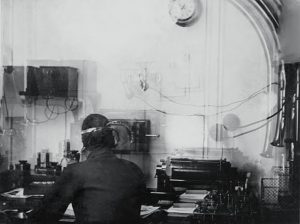
Public Domain/Wikimedia Commons
As Titanic traveled on, by 13 April it had gone about 519 miles. During this time, she received many warnings of ice. At 10:30 PM, she got a warning of heavy pack ice from the Rappahannock. The weather was starting to change. The nice spring weather was going to be replaced by a cold front that by noon the next day would have people wearing heavy clothing and scarves if they wanted to walk outside.
Sources
Books
Behe, George TITANIC: SAFETY, SPEED AND SACRIFICE, Transportation Trails, Polo, IL 1997
Eaton John P. & Haas Charles, TITANIC TRIUMPH AND TRAGEDY, SECOND EDITION, W.W. Norton & Company, New York, New York, 1995 First American Edition
Lord, Walter, A NIGHT TO REMEMBER, Holt Rinehart and Winston, New York, New York, 1955. Multiple revisions and reprints, notably Illustrated editions (1976,1977,1978 etc)
Lord, Walter, THE NIGHT LIVES ON, Willian Morrow and Company, New York, New York, 1986 (First Edition)
Lynch, Don & Marshall Ken, TITANIC AN ILLUSTRATED HISTORY, Madison Press Books, Toronto, Ontario Canada, 1992
Internet
Encyclopedia Britannica, www.britannica.com/search?query=Titanic.
“Encyclopedia Titanica.” www.encyclopedia-titanica.org.
“The Titanic: Sinking and Facts | HISTORY.” HISTORY, 12 Mar. 2024, www.history.com/topics/early-20th-century-us/titanic.










